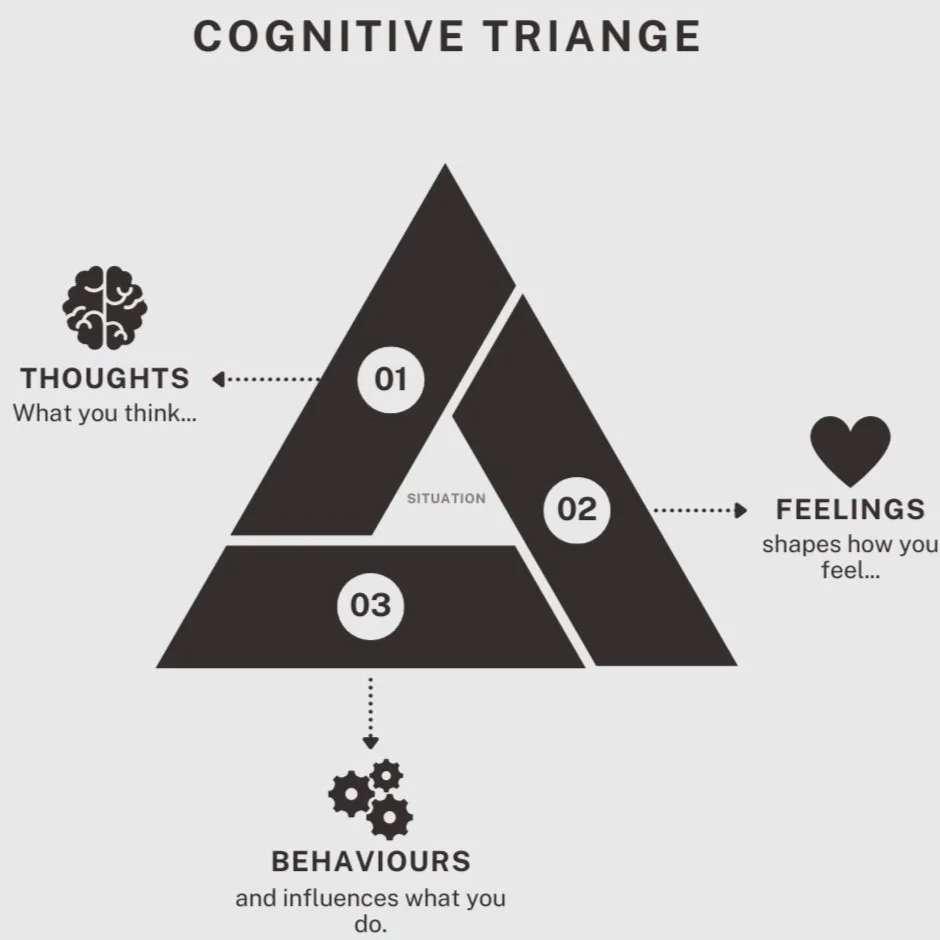Thought Record
A thought record is a tool used in Cognitive Behavioural Therapy (CBT) to help a person identify and challenge negative or unhelpful thoughts. It allows a person to explore the connection between their thoughts, feelings, and behaviours, a concept known as the Cognitive Triangle. Through understanding this relationship, a person can take greater control over their responses and make meaningful life changes.
CBT begins with psychoeducation to help clients understand these foundational principles, with some practitioners adapting this model to address more specific concerns such as social anxiety disorder (Clark & Wells, 1995), obsessive compulsive disorder (Salkovskis, 1985) and trauma (Ehlers & Clark, 2000). This understanding forms the foundation of CBT, with many techniques reliant on this understanding.
“People’s emotions and behaviours are influenced by their perceptions of events. It’s not the situation itself that determines what people feel, but rather how they construe the situation.”
Once a person understands the connection between their thoughts, feelings, and behaviours, the next step is to identify the specific thoughts that may be contributing to their current concerns. This is where a thought record can be really useful! We can use a thought record to look for unhelpful thinking patterns, such as catastrophising, black-and-white thinking, or overgeneralising.
For example, imagine a person receives a message from their manager saying, “Can we have a quick chat later?” Their first thought might be: “I must be in trouble — I’m going to get fired.” This is an example of catastrophising — assuming the worst without looking at the evidence. The feeling might be anxiety or panic, and the behaviour could be avoiding the conversation, over-preparing, or asking for reassurance.
Instead, a person can use the thought record to identify patterns in their thinking and begin to challenging their thoughts. By putting them on trial and questioning their validity, we begin to see that they may not be as true or threatening as they first seemed. Below is an example of a thought record, which can help you track your thoughts, feelings, and behaviours:
Clients often find thought records helpful because they slow down mental processes and provide a structured way to examine thoughts more objectively. By making thoughts visible and breaking them down, thought records help create distance, allowing a person to gain perspective and a greater sense of control.
References
Beck, J. S. (1995). Cognitive therapy: Basics and beyond. Guilford Press.
Clark, D. M., & Wells, A. (1995). A cognitive model of social phobia. In R. G. Heimberg, M. R. Liebowitz, D. A. Hope, & F. R. Schneier (Eds.), Social phobia: Diagnosis, assessment, and treatment (pp. 69–93). Guilford Press.
Ehlers, A., & Clark, D. M. (2000). A cognitive model of posttraumatic stress disorder. Behaviour Research and Therapy, 38(4), 319–345. https://doi.org/10.1016/S0005-7967(99)00123-0
Salkovskis, P. M. (1985). Obsessive-compulsive problems: A cognitive-behavioural analysis. Behaviour Research and Therapy, 23(5), 571–583. https://doi.org/10.1016/0005-7967(85)90105-6
